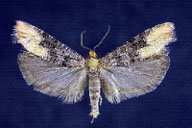Southwestern pine tip moth
Rhyacionia neomexicana (Dyar) (Lepidoptera: Tortricidae)
Orientation to pest
The southwestern pine tip moth, Rhyacionia neomexicana (Dyar), is a native North American tip moth that distorts and kills terminals of young ponderosa pine (Pinus ponderosa Douglas ex Lawson) in Arizona, New Mexico, Colorado, the Dakotas, and Nebraska. Moths fly in spring laying eggs as new needles emerge. Eggs hatch in 2-3 weeks, and small larvae feed inside needles. Later, larvae feed inside needle sheaths or buds and eventually the large larvae hollow out growing shoots. Larval feeding under the bark of new shoots produces girdling wounds that cause shoots to turn brown and become crooked. Mature larvae leave the tips during summer and spin cocoons, usually in the bark crevices on the base of the tree below the litter, where they pupate and overwinter. There is one generation per year. Heavy infestation for consecutive years may retard growth, leaving trees short and bushy. Trees are affected in both plantations and natural forests. Injury is most severe where trees are planted on poor sites.
Hosts commonly attacked
In North America, this moth attacks ponderosa (P. ponderosa), Austrian (Pinus nigra J. F. Arnold), mugho (Pinus mugo Turra), Scots (Pinus sylvestris L.), and foxtail (Pinus balfouriana Balf.) pines.
Distribution
This moth occurs in the United States in Arizona, New Mexico, Utah, Colorado, the Dakotas, Montana, and Nebraska.
Images of southwestern pine tip moth
| Figure 1. Adult of southwestern pine tip moth, Rhyacionia neomexicana |
Important biological control agents related to this pest species
Little to no information is available on the natural enemies of this species.
Web links for information on southwestern pine tip moth
- BugwoodWiki Article | wiki.bugwood.org
- Fact Sheet | Colorado State University Extension
- Forest Insect & Disease Leaflet 58 | USDA Forest Service
Articles
- Jennings, D. T. 1975. Life history and habits of the southwestern pine tip moth, Rhyacionia neomexicana (Dyar) (Lepidoptera: Olethreutidae). Annals of the Entomological Society of America 68: 597-606.
- Stevens, R. E. and D. T. Jennings. 1977. Western pine-shoot borer: a threat to intensive management of ponderosa pine in the Rocky Mountain area and Southwest. USDA Forest Service General Technical Report, Rocky Mountain Forest and Range Experiment Station, RM-45.
- Wagner, M. R. and Z. Chen. 2004. Long-term benefits to the growth of ponderosa pines from controlling southwestern pine tip moth (Lepidoptera: Tortricidae) and weeds. Journal of Economic Entomology 97: 1972-1977.




